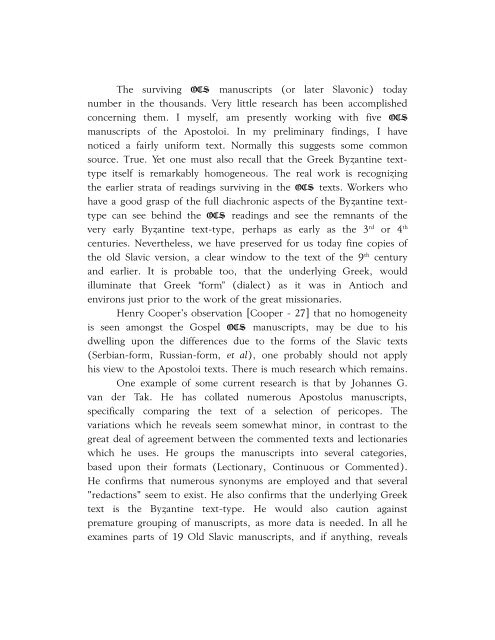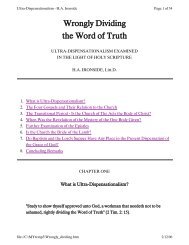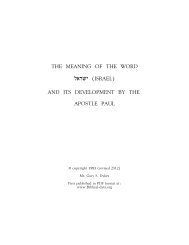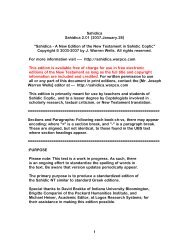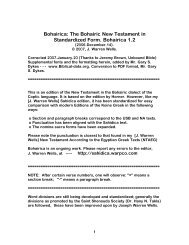OCS and the Greek New Testament - Biblical-data.org
OCS and the Greek New Testament - Biblical-data.org
OCS and the Greek New Testament - Biblical-data.org
You also want an ePaper? Increase the reach of your titles
YUMPU automatically turns print PDFs into web optimized ePapers that Google loves.
The surviving Ú manuscripts (or later Slavonic) today<br />
number in <strong>the</strong> thous<strong>and</strong>s. Very little research has been accomplished<br />
concerning <strong>the</strong>m. I myself, am presently working with five Ú<br />
manuscripts of <strong>the</strong> Apostoloi. In my preliminary findings, I have<br />
noticed a fairly uniform text. Normally this suggests some common<br />
source. True. Yet one must also recall that <strong>the</strong> <strong>Greek</strong> Byzantine texttype<br />
itself is remarkably homogeneous. The real work is recognizing<br />
<strong>the</strong> earlier strata of readings surviving in <strong>the</strong> Ú texts. Workers who<br />
have a good grasp of <strong>the</strong> full diachronic aspects of <strong>the</strong> Byzantine texttype<br />
can see behind <strong>the</strong> Ú readings <strong>and</strong> see <strong>the</strong> remnants of <strong>the</strong><br />
very early Byzantine text-type, perhaps as early as <strong>the</strong> 3rd or 4th centuries. Never<strong>the</strong>less, we have preserved for us today fine copies of<br />
<strong>the</strong> old Slavic version, a clear window to <strong>the</strong> text of <strong>the</strong> 9th century<br />
<strong>and</strong> earlier. It is probable too, that <strong>the</strong> underlying <strong>Greek</strong>, would<br />
illuminate that <strong>Greek</strong> “ form ” (dialect) as it was in Antioch <strong>and</strong><br />
environs just prior to <strong>the</strong> work of <strong>the</strong> great missionaries.<br />
Henry Cooper's observation [Cooper - 27] that no homogeneity<br />
is seen amongst <strong>the</strong> Gospel Ú manuscripts, may be due to his<br />
dwelling upon <strong>the</strong> differences due to <strong>the</strong> forms of <strong>the</strong> Slavic texts<br />
(Serbian-form, Russian-form, et al), one probably should not apply<br />
his view to <strong>the</strong> Apostoloi texts. There is much research which remains.<br />
One example of some current research is that by Johannes G.<br />
van der Tak. He has collated numerous Apostolus manuscripts,<br />
specifically comparing <strong>the</strong> text of a selection of pericopes. The<br />
variations which he reveals seem somewhat minor, in contrast to <strong>the</strong><br />
great deal of agreement between <strong>the</strong> commented texts <strong>and</strong> lectionaries<br />
which he uses. He groups <strong>the</strong> manuscripts into several categories,<br />
based upon <strong>the</strong>ir formats (Lectionary, Continuous or Commented).<br />
He confirms that numerous synonyms are employed <strong>and</strong> that several<br />
"redactions" seem to exist. He also confirms that <strong>the</strong> underlying <strong>Greek</strong><br />
text is <strong>the</strong> Byzantine text-type. He would also caution against<br />
premature grouping of manuscripts, as more <strong>data</strong> is needed. In all he<br />
examines parts of 19 Old Slavic manuscripts, <strong>and</strong> if anything, reveals


